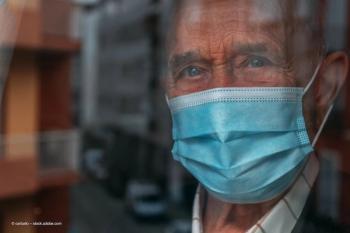
Resident and consultant ophthalmologists compare immediate sequential bilateral cataract surgery successes
A new study compared results to determine a more comprehensive understanding of the relationship between the grade of surgeon and ISBCS outcomes
Rajesh Deshmukh, MBBS, FRCS, and colleagues from Moorfields Eye Hospital, London, reported that resident ophthalmologists and consultant ophthalmologists had similar outcomes when performing immediate sequential bilateral cataract surgeries (ISBCS).1 They published their findings in Eye.
The COVID-19 pandemic was an important factor in the increasing popularity of ISBCS. Before the pandemic, the investigators explained, “ISBCS were reserved for complex health needs, paediatric patients, or patients with health anxieties undergoing general anaesthesia. More recently, ISBCS has gained popularity since the COVID-19 pandemic restrictions resulted in a backlog of unoperated cataracts worldwide.”2,3
The advantages of performing a patient’s cataracts surgeries simultaneously are faster visual rehabilitation, improved vision-related quality of life, and higher productivity.4 When ISBCS were performed during the pandemic, the risk of spreading the virus was reduced by lower hospital attendance.5
The reasons that many surgeons adhered to the standard practice of performing one cataract surgery at a time were concerns about bilateral complications, the inability to adjust intraocular lens power in the second eye, and the lack of established protocols for transitioning to ISBCS,6,7 Dr. Deshmukh and colleagues explained. The International Society of Bilateral Cataract Surgeons has recently noted an increasing ISBCS acceptance in well-selected cases.8,9
The rationale for the study under discussion is that the experience level of the operating surgeon is a potential factor affecting the outcomes of all ophthalmic procedures, including ISBCS. “Previous studies have shown promising results for ISBCS performed by consultants and senior residents, but these studies had relatively small sample sizes.”10,11 Given the limited evidence on the impact of surgical experience on ISBCS outcomes, this study provided an opportunity to compare the outcomes of ISBCS performed over 3 years by resident ophthalmologists and consultant ophthalmologists to gain a more comprehensive understanding of the relationship between the grade of surgeon and ISBCS outcomes, they explained.
In all of the cataract surgeries, phacoemulsification and intraocular lens implantation were performed. The study outcomes were complications, refraction (spherical equivalent (SE) > 0.5 diopter [D] and >1.0 D from the predicted target refraction), and the uncorrected distance visual acuity (UDVA) logarithm of the minimum angle of resolution [logMAR]) at 3 months postoperatively. Resident ophthalmologists operated on 553 eyes and consultant ophthalmologists 687 eyes.
The investigators reported that the postoperative UDVAs were similar in both groups (P = 0.26). The intra- and postoperative complications also were comparable between the groups (risk ratio, 1.88; 95% confidence interval, 0.8; 4.2) (P = 0.13).
No significant differences were seen in the refractive outcomes between the groups (residents, –0.12 D; interquartile range [IQR], –0.5; –0.25); consultants, –0.25 D; IQR, –0.63; –0.13) (P = 0.08). There also were no differences found in patients with >1.0 D SE predicted refractive outcome between the groups (6% of residents and 3.9% of consultants (P = 0.142). The grade of the surgeon, risk of posterior capsular rupture, and predicted refraction were not significant predictors of the postoperative refractive error (SE > 0.5 D).
“Our findings support training in ISBCS of junior surgeons under supervision whilst managing the service needs to address the rising burden of disease. Our study can be used as clear and concise evidence when preparing written information on common themes and patients’ concerns, as recommended by Campbell et al.12 The low complication rate in both groups is heartening and encourages the promoters of ISBCS in the UK. Although the proposed target of achieving <1 D refraction in more than 85% is attained, surgeons should aim to improve their goal of achieving <0.5 D in more eyes undergoing ISBCS by ongoing self-audit.”
The authors advised that the residents need supervised training to minimise the risk of posterior capsular tears.
References
- Deshmukh R, Malik M, Myers S, et al. Outcomes of immediate sequential bilateral cataract surgeries (ISBCS) performed by trainees vs consultants: a two-armed cohort study. Eye 2025;39:1724–1729.
https://doi.org/10.1038/s41433-025-03739-9 - Dickman MM, Spekreijse LS, Winkens B, et al. Immediate sequential bilateral surgery versus delayed sequential bilateral surgery for cataracts. Cochrane Database Syst Rev. 2022;4:CD013270.
- Nowrouzi A, Alió JL. Immediately sequential bilateral cataract surgery. Curr Opin Ophthalmol. 2024;35:17–22.
- Alió JL, Nowrouzi A. Immediately sequential bilateral cataract surgery importance during the COVID-19 pandemic. Saudi J Ophthalmol. 2022;36:124–128.
- Sandhu S, Liu D, Mathura P, Palakkamanil M, et al. Immediately sequential bilateral cataract surgery (ISBCS) adapted protocol during COVID-19. Can J Ophthalmol. 2023;58:171–178.
- Obuchowska I, Micun Z, Młynarczyk M, Dmuchowska DA, Konopińska J. Pros and cons of immediate sequential bilateral cataract surgery from a patient perspective: a survey. Int J Environ Res Public Health. 2023;20:1611.
- You E, Hébert M, Arsenault R, Légaré M-È, Mercier M. Perception of Canadian ophthalmologists on immediately sequential bilateral cataract surgery: insights and implications. Can J Ophthalmol. 2024;59:146–153.
- Lundström M, Kugelberg M, Zetterberg M, et al. Ten-year trends of immediate sequential bilateral cataract surgery (ISBCS) as reflected in the Swedish National Cataract Register. Acta Ophthalmol (Copenh). 2024;102:68–73.
- Arshinoff S, Claoue C, Johansson B, et al. Immediately sequential bilateral cataract surgery (ISBCS): global history and methodology, 1st ed. New York: Elsevier; 2022. Available at:
https://shop.elsevier.com/books/immediately-sequential-bilateral-cataract-surgery-isbcs/arshinoff/978-0-323-95309-2 - Wang H, Ramjiani V, Auger G, Raynor M, Currie Z, Tan J. Practice of immediate sequential bilateral cataract surgery (ISBCS): A teaching hospital experience in United Kingdom. Eur J Ophthalmol. 2023;33:1959–1968.
- Chen TA, Chen SP, Ahmad TR, Pasricha ND, Parikh N, Ramanathan S. Resident-performed immediate sequential bilateral cataract surgery during the COVID-19 pandemic. Indian J Ophthalmol. 2021;69:1579–1584.
- Campbell CG, La CJ, Chan KL, Turnbull AMJ. Patient satisfaction and attitudes towards immediate sequential bilateral cataract surgery. Eur J Ophthalmol. 2023;33:1952–1958.
Newsletter
Get the essential updates shaping the future of pharma manufacturing and compliance—subscribe today to Pharmaceutical Technology and never miss a breakthrough.




